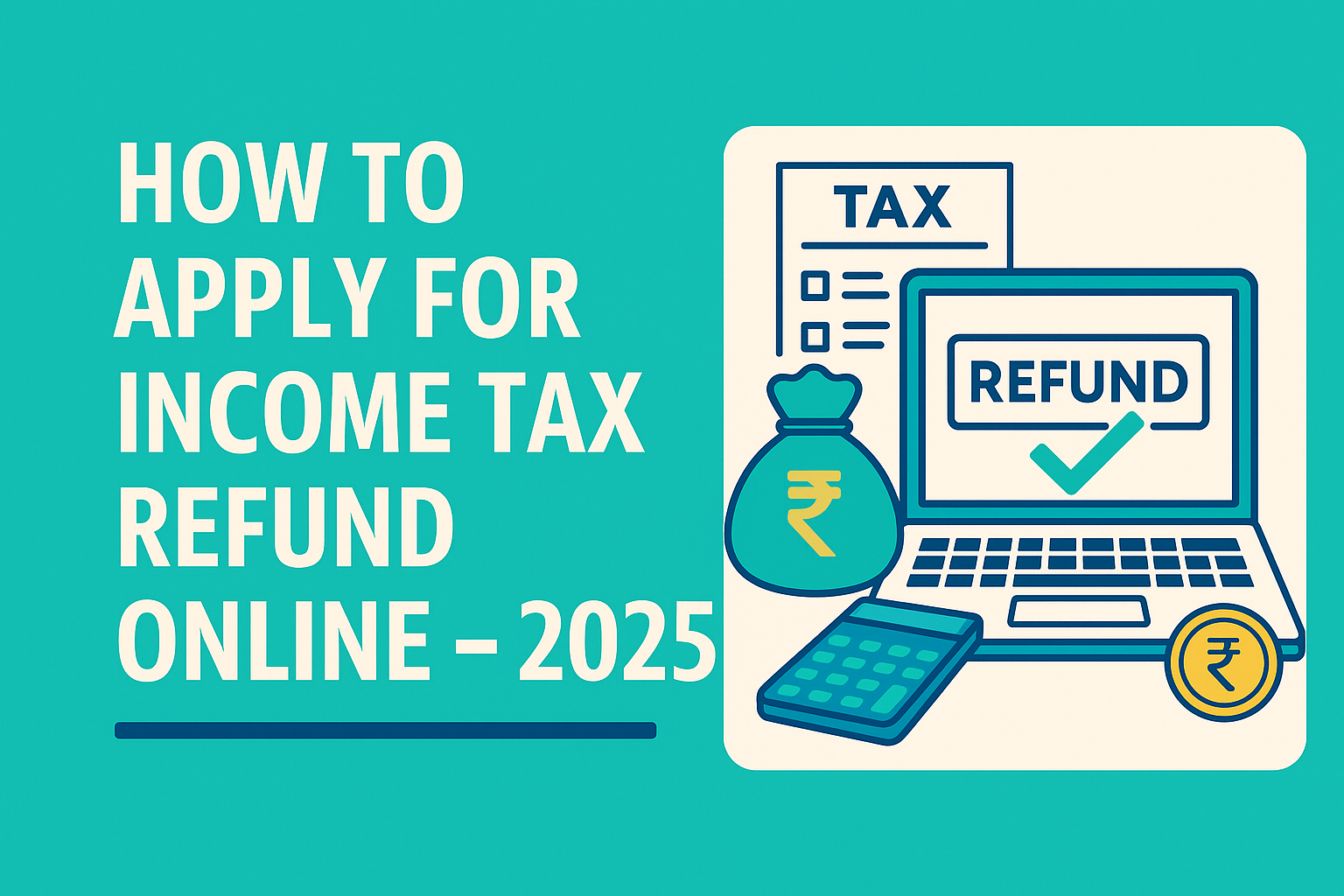🟩 Part 1: Introduction – What Is an Income Tax Refund?
Ever paid more tax than you were supposed to? That’s where an income tax refund comes in.
A refund is the extra money you paid as income tax that the government owes you back—simple as that. It usually happens when:
- Employers deduct TDS assuming higher income than actual
- You invested in tax-saving schemes (like 80C) but didn’t submit proofs on time
- You paid advance/self-assessment tax but ended up with lower actual tax liability
In 2025, filing your Income Tax Return (ITR) correctly and claiming your refund online is easier than ever. The Income Tax Department now supports auto-filled forms, real-time refund tracking, and faster credit to your bank.
In this guide, we’ll take you through every step—from checking eligibility to claiming, tracking, and resolving refund delays.
🟩 Part 2: Who Is Eligible for a Tax Refund?
You’re eligible for a refund if you paid more tax than your actual liability for a financial year. Here are the most common scenarios:
✅ Salaried Employees
Often face TDS deductions based on estimated salary, but later end up with lower tax due—especially if you’ve claimed deductions under sections like 80C, 80D, or HRA.
✅ Freelancers & Self-Employed
May pay advance tax based on projected earnings. If actual income falls short, the excess tax paid becomes refundable.
✅ Senior Citizens
Even if TDS is deducted on FD interest, many senior citizens fall below taxable limits due to high exemption slabs. Refunds are often due.
✅ NRIs
If an NRI earns interest or rent in India and TDS is deducted, but they’re below the threshold or have DTAA benefits, they’re eligible for a refund.
✅ Homemakers
If a housewife earns income from interest or rent, and TDS is deducted, but her total income is non-taxable, she can claim a refund too.
In short, any taxpayer whose total tax paid > total tax liability can file for a refund by submitting a proper ITR.
🟩 Part 3: Conditions When Refund Is Applicable
A tax refund isn’t automatic—it’s triggered when your tax liability is less than the tax already paid. Here are key situations where a refund becomes applicable:
✅ 1. TDS Deducted but Income Below Taxable Limit
This is especially common among:
- Students doing internships
- Senior citizens with FD interest
- Part-time freelancers
Despite earning below ₹2.5 lakh (or relevant exemption limit), TDS is often deducted—creating scope for a full refund.
✅ 2. Excess Advance or Self-Assessment Tax Paid
If you paid conservative or overestimated advance tax to avoid interest or penalties, and your actual income is lower—then refund is due.
✅ 3. Investment Proofs Not Considered by Employer
Many employees forget or are late in submitting:
- LIC, ELSS, or PPF documents
- Home loan interest
- Tuition fees for children
You can still claim them in your ITR, reducing tax liability and triggering a refund.
✅ 4. Income Clubbing/Adjustment Errors
If you reported your spouse or minor child’s income by mistake, or didn’t adjust losses, you may be eligible for a refund after correction.
✅ 5. Double Taxation for NRIs
If tax is paid in both India and abroad on the same income and you’re eligible for DTAA relief, you can claim a refund on excess tax paid in India.
🟩 Part 3: Conditions When Refund Is Applicable
A tax refund isn’t automatic—it’s triggered when your tax liability is less than the tax already paid. Here are key situations where a refund becomes applicable:
✅ 1. TDS Deducted but Income Below Taxable Limit
This is especially common among:
- Students doing internships
- Senior citizens with FD interest
- Part-time freelancers
Despite earning below ₹2.5 lakh (or relevant exemption limit), TDS is often deducted—creating scope for a full refund.
✅ 2. Excess Advance or Self-Assessment Tax Paid
If you paid conservative or overestimated advance tax to avoid interest or penalties, and your actual income is lower—then refund is due.
✅ 3. Investment Proofs Not Considered by Employer
Many employees forget or are late in submitting:
- LIC, ELSS, or PPF documents
- Home loan interest
- Tuition fees for children
You can still claim them in your ITR, reducing tax liability and triggering a refund.
✅ 4. Income Clubbing/Adjustment Errors
If you reported your spouse or minor child’s income by mistake, or didn’t adjust losses, you may be eligible for a refund after correction.
✅ 5. Double Taxation for NRIs
If tax is paid in both India and abroad on the same income and you’re eligible for DTAA relief, you can claim a refund on excess tax paid in India.
🟩 Part 4: Documents You Need to Claim Refund
Claiming an income tax refund online doesn’t require physical documents to be submitted—but you do need to have the following ready while filing your return:
📄 1. PAN Card
Mandatory for every taxpayer. Make sure it’s linked to Aadhaar and active on the e-filing portal.
📄 2. Aadhaar Card
Required for e-verification of your ITR and PAN linkage. Ensure your date of birth and name match exactly.
📄 3. Form 16 (For Salaried Individuals)
This document issued by your employer shows:
- Gross income
- TDS deducted
- Section-wise deductions (80C, 80D etc.)
📄 4. Form 26AS and AIS (Annual Information Statement)
These are auto-populated summaries from the IT Department showing:
- TDS
- Advance tax paid
- SFT transactions
You must cross-check these with your ITR for accuracy.
📄 5. Bank Account Details
- Account must be pre-validated and linked with PAN
- Use a savings account, not a joint account for hassle-free refund credit
- IFSC code must be accurate
📄 6. ITR Acknowledgement or JSON File
If you’re filing through offline JSON upload, this file is needed. Save the ITR-V (Acknowledgement) for records.
🟩 Part 5: Step-by-Step Process to Apply for Income Tax Refund Online
Here’s a simple step-by-step guide to file your ITR and claim your refund online using the official Income Tax e-Filing Portal:
✅ Step 1: Login to the Income Tax Portal
- Visit incometax.gov.in
- Use your PAN (as user ID) and password
- If new, click “Register”
✅ Step 2: Start Filing ITR
- Go to e-File > Income Tax Return > File Income Tax Return
- Choose the correct Assessment Year (AY 2024–25)
- Select the appropriate mode (online preferred)
✅ Step 3: Choose the Right ITR Form
- ITR-1: For salaried individuals with one house property
- ITR-2/3: For income from capital gains or business/profession
- ITR-4: For presumptive taxation (small businesses)
✅ Step 4: Fill in Your Income Details
- Import pre-filled data from PAN, AIS, Form 26AS
- Enter any other income manually (interest, rent, etc.)
- Double-check for accuracy
✅ Step 5: Declare Deductions & Tax Reliefs
- Input deductions under Section 80C, 80D, 80G, etc.
- Declare any relief under Section 89 or DTAA
✅ Step 6: Validate Tax Summary & Refund
- Portal will auto-calculate your tax payable or refund amount
- Review carefully before final submission
✅ Step 7: Submit ITR and E-Verify
- Submit your return
- Choose e-verification methods:
- Aadhaar OTP
- Net banking
- Demat account
- Bank ATM
- No refund will be processed unless ITR is verified
Once e-verification is successful, your ITR will be processed by CPC Bengaluru, and the refund will be credited directly to your bank.
🟩 Part 6: How to Track Your Refund Status
After successfully filing and verifying your ITR, you can easily track the status of your income tax refund online. Here’s how:
🔍 Option 1: Through the Income Tax e-Filing Portal
- Login to incometax.gov.in
- Go to “e-File” > “Income Tax Returns” > “View Filed Returns”
- Click on the latest ITR acknowledgment number
- Scroll down to check:
- ITR status (Filed / Processed)
- Refund Status (Refund issued / Under processing / Failed)
- Date of credit to bank
🔍 Option 2: Through NSDL’s Refund Tracking Website
- Visit https://tin.tin.nsdl.com/oltas/refundstatuslogin.html
- Enter:
- PAN
- Assessment Year
- Captcha
- It will show your refund dispatch status (credited, returned, or under process)
🔍 Option 3: Email or SMS Alerts
You will receive:
- SMS updates on your registered mobile number
- Email alerts about refund issued or failure reasons
Make sure your mobile and email are updated in your profile.
🟩 Part 7: What If You Haven’t Received Your Refund?
If your ITR is processed but you haven’t received the refund yet, don’t panic. Here are the most common reasons and how to resolve them:
⚠️ 1. Bank Account Not Pre-Validated
Your refund won’t be processed if your bank account isn’t pre-validated and linked to your PAN.
✅ Fix:
- Login to incometax.gov.in
- Go to “My Profile > My Bank Account”
- Add or validate the correct account
- Re-raise refund reissue request
⚠️ 2. ITR Not e-Verified
Many taxpayers forget to e-verify after filing. No e-verification = no processing.
✅ Fix:
E-verify through:
- Aadhaar OTP
- Net banking
- Bank ATM
- Demat account
⚠️ 3. Mismatch in Details
- Name mismatch between PAN and bank
- Wrong IFSC code
- Incorrect account number
✅ Fix:
Update bank details on portal > Request for refund re-issue.
⚠️ 4. IT Department Still Processing Return
Sometimes it takes time for CPC to process your return. Refunds usually take 7 to 45 days.
✅ Fix:
Track status via:
- e-Filing portal
- NSDL website
- CPC contact number: 1800 103 4455
⚠️ 5. Refund Adjusted Against Outstanding Tax
If you have any past tax dues, your refund might be adjusted automatically. You’ll get an intimation under Section 245.
✅ Fix:
Login and check your ITR intimation for any such adjustments.
🟩 Part 8: Conclusion – Don’t Miss Out on What’s Rightfully Yours
Filing your Income Tax Return isn’t just a compliance requirement—it’s also your gateway to recovering money that’s rightfully yours.
If TDS has been deducted, or you’ve paid advance/self-assessment tax, don’t let it go unclaimed. A few clicks on the Income Tax Portal can put that money back in your account—interest included if delays occur.
🔗 You may also find these guides helpful:
- How to Check PF Balance Without Internet – 2025 Guide
- How to Apply for PAN Card Correction Online – 2025 Guide
- How to Link PAN with Aadhaar Online – 2025
- How to Get Your Marriage Certificate Online in India – 2025 Guide
- How to Apply for Income Certificate Online – 2025
💡 Pro Tip: File your returns well before the due date to avoid last-minute issues, interest charges, or missing out on eligible refunds.
Want more such easy guides? Bookmark SmartIndiaHelp.com – your trusted portal for making online government services easy.

